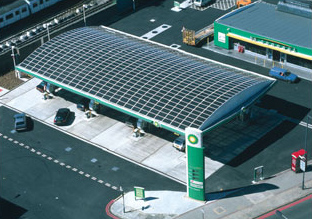3.1 Solar radiation
Over 99.9% of the energy available at the Earth's surface comes from the Sun. Solar energy emanates from a vast nuclear powerhouse producing heat, light and other types of electromagnetic radiation released by nuclear reactions. The Sun's power output is enormous, some 1014 TW, but only a tiny proportion, about 1.7 × 105 TW, reaches the Earth. About a third of this is reflected by clouds and the Earth's surface directly back into space (Figure 1.7).
Question 4
How much energy reaches the Earth (surface and atmosphere together) from the Sun each year? (Don't forget the numbers in Figure 1.7 are in terms of power.)
Answer
The Sun supplies 1.7 × 105TW to the Earth, of which 1.1 × 105TW enters the Earth's system (0.3 × 105TW to atmospheric heating + 0.8 × 105TW absorbed at the surface, see Figure 1.7). 1.1 × 105TW is equivalent to 1.1 × 1017 J s−1, and since there are 3.15 × 107 s in a year, the Sun's annual energy supply is 3.15 × 107 s × 1.1 × 1017 J s−1 = 3.5 × 1024 J or 3.5 × 106 EJ.
If all the solar energy that reaches the Earth could be harnessed, current human needs would be supplied thousands of times over. The reason it cannot is explained later.
Solar radiation is potentially available as an energy resource either as direct solar energy using solar cells or heating devices (Figure 1.8), or naturally through plant and animal growth. Some 50 000 TW of absorbed solar radiation is transferred back into the atmosphere through evaporation and convection (Figure 1.7). Some of this energy reappears in a usable form when water eventually returns to the surface as precipitation. This energy is largely dissipated as frictional heat and sound during the return flow of the water to the oceans, but it can also be harnessed as hydropower, an indirect form of solar energy.

However, if the electrical power requirement of an average British household — around 3 kW — came from solar energy alone, even if every day were sunny each dwelling in Britain would need about 100 m2 of solar panels, on a very large south-facing roof. But is solar energy the answer to energy supply in sunnier parts of the world?
Question 5
California has an area of about 4.1 × 1011 m2. Even if the Sun shines there for 12 hours each and every day of the year, what percentage of California's land surface area would need to be covered by solar panels to supply the energy demands of the whole of the USA? The USA used 96.5 EJ of energy in 2003. A 10% efficient, metre-square solar panel would supply 31 J every second.
Answer
Assuming that solar panels operated for 1.6 × 107 seconds a year (12 hours a day), one such panel would supply about 5 × 108 J. The USA would therefore need around 2.0 × 1011 such panels (i.e. 96.5 × 1018 J divided by 5 × 108 J). Since the area of California is 4.1 × 1011 m2, about 50% of it would have to be covered by solar panels to meet US energy demand. (The assumptions we have made are so unrealistic that the figure would be much higher, were a 'solar energy only' scheme to be implemented.)
What happens to the solar energy that reaches the Earth's surface? Because the Earth is a sphere, the heating effect of the Sun is greater in equatorial latitudes than at the poles. Coupled with the Earth's rotation, this produces winds which blow between belts of high and low atmospheric pressure. About 10% of the Earth's absorbed solar power (10 000 TW) gives rise to winds (Figure 1.7). Much of the energy of winds is dissipated as heat, but some 10% of this wind power (i.e. 1000 TW) is transferred to waves through frictional effects at the sea surface.
Question 6
Could the world be supplied from wind and wave power one day?
Answer
Theoretically, yes, but practically, no. Total global wind power amounts to 10 000 TW, i.e. around one thousand times human power demands. However, tapping wind power over one-thousandth of the world's surface (some 510 000 km2 or over twice the size of Britain) would be a colossal undertaking and the process would have to be fully efficient. Similar arguments apply to wave power, except that here a maximum of 1000 TW is theoretically available (100 times annual demand), requiring twice the surface area of the Mediterranean Sea to be tapped at 100% efficiency.
